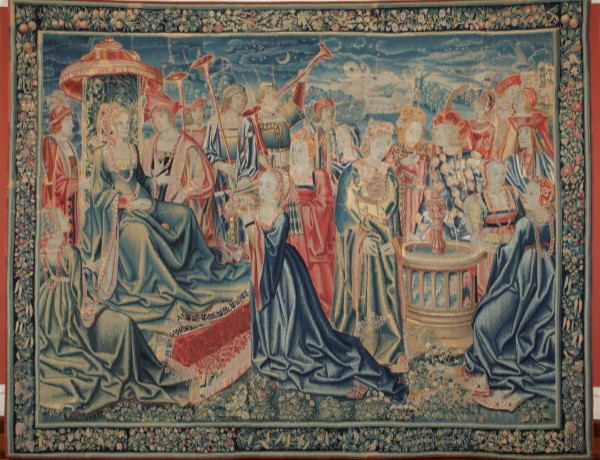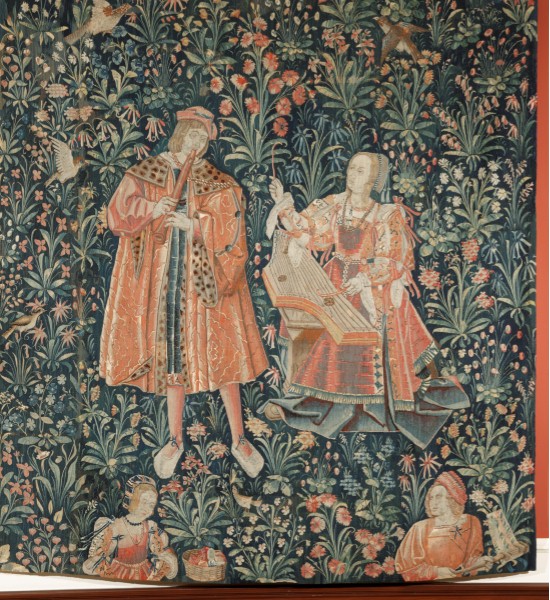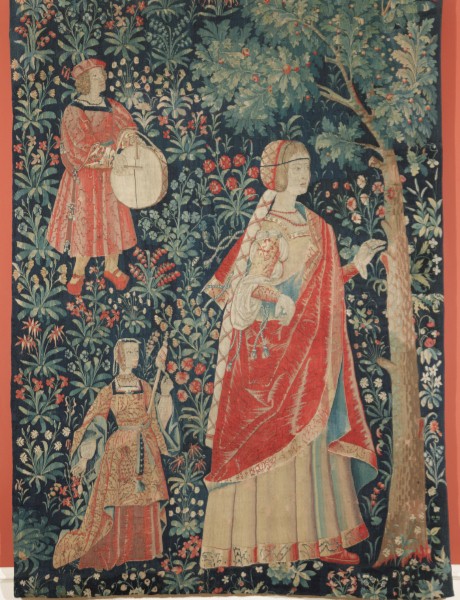HISTORIC EUROPEAN TAPESTRIES RETURN TO THE FRICK ART MUSEUM FOLLOWING CONSERVATION
As of February 20, 2018, all four tapestries purchased by Helen Clay Frick for The Frick Art Museum rotunda are once again on display.
Three of the four tapestries were removed in early 2017 to receive conservation treatment, which was generously funded by a grant from the Bank of America Art Conservation Project. (The fourth received conservation in 2013 with funding provided by the National Endowment for the Arts.) The public is invited to visit The Frick Art Museum to view the tapestries, which are on permanent display in the rotunda. Admission to view the permanent collection is free.
All the tapestries in the Frick’s collection date to around 1510 and reflect the advanced skills of artists creating sumptuous and complex pictorial weavings at a time when fine tapestries were more valuable than paintings—due to the cost of materials and the months of labor required for their production. Tapestries were a status symbol in demand by important patrons like Pope Leo X (1475-1521), Henry VIII (1491-1547) of England, and François I of France (1494-1547).
Tapestries experience unique conservation issues—over time, gaps begin to form between colors and their own weight pulls on the fibers causing breakage. Staining and fading can also be issues, as can earlier repairs that age or discolor differently than the original weaving.
The conservation treatment was completed by expert textile conservator Julia Dippold, who has worked with the Frick’s tapestry collection for nearly twenty years and has completed projects for major museums and collections internationally, including the Ringling Museum, the Philadelphia Museum of Art, the Metropolitan Museum of Art, and the National Gallery of Art.
Treatment began with a gentle vacuuming, with low suction, through a protective screen, which removed surface dirt and dust. Vacuuming was followed by careful wet cleaning, removal and consolidation of old repairs, closing of the gaps between the colors, and repairing losses to the image as necessary. This treatment, which has brightened and sharpened the imagery of the tapestries, will also greatly reduce progressive loss over the next several decades.
One of the returning tapestries, The Court of Love, was woven in Brussels and is an excellent example of the painterly, narrative compositions that made Brussels a famed center of tapestry production. From the end of the 1400s through the 1800s Brussels was a major center of tapestry production. The tapestries produced there rank among the most luxurious and skillfully constructed in the world.

Flemish weavers were adept at a dovetail weaving technique that allowed them to use a variety of colors in interlocking triangles called hachures—the hachures function almost like brushstrokes, creating the shading in the draperies, the dynamic qualities of the sky, and the surprisingly expressive faces of the figures. Because of its size and compositional complexity The Court of Love required the most extensive treatment of the group. Nineteenth-century repairs made with cotton deteriorated more rapidly than the tapestry’s wool warp. Additionally, the stiches holding the weaving slits (gaps between colors) closed were beginning to fracture, and had left small holes throughout the tapestry. As Ms. Dippold worked on this tapestry she reported, “I am really pleased with the results of replacing the slit stitches in the faces and hands of all the figures. I am also spending a bit more time on the sky portion of the tapestry. These weaving slits were not previously repaired well. The replacement stitches will give the top portion of the tapestry greater structural strength as well as clarifying the design.”
The other two tapestries, Two Musicians, and Lady and Attendants are from the French Loire valley mille fleurs (thousand flowers) tradition. Both of these tapestries depict subjects typical of the late Medieval and early Renaissance period—namely romantic visions of court life—garden strolls, picnics, and outdoor entertainments with music. In contrast to the Flemish weaving style, the milles fleurs works are more Medieval in character—there is no illusionistic sense of depth to the composition, and there is little attempt to create a sense of the figures occupying real space. However, these French tapestries with their botanically recognizable flowers and scenes of courtly life, have an enduring decorative charm. The complex backgrounds, with their many details and changes in yarn color create more weaving slits, and therefore, more opportunities for the tapestry to open up and experience losses over time. Conservation has closed these gaps and stabilized the tapestries for decades to come.


Frick Director Robin Nicholson says, “The much-needed conservation work generously underwritten by the Bank of America Conservation Project will ensure that the Frick’s historic tapestries remain intact for the enjoyment of future generations. We are delighted to have the complete set of four tapestries back on view after a period of absence, and invite the public to visit the museum and see them on display.”
“The Art Conservation Project is a major component of Bank of America’s support of the arts worldwide and a key demonstration of our commitment to operating in a responsible way that contributes to the health of the communities in which we serve,” said Brian Ludwick, Bank of America Pittsburgh Market President. “We are proud of our long-standing partnership with the Frick and the role we played in helping to restore these remarkable pieces of art.”

Images:
Detail images, before, during and after conservation treatment: The Court of Love, Tapestry, Flemish, early 16th century. Frick Art & Historical Center, Pittsburgh, 1970.30
Maker Unknown French, School of Loire Two Musicians, c. 1500 Frick Art & Historical Center, 1970.53
Maker Unknown French, School of Loire Lady and Attendants, c. 1500 Frick Art & Historical Center, 1970.54
Maker Unknown Flemish, Brussels The Court of Love, c. 1500 Frick Art & Historical Center, 1970.30
All the tapestries in the Frick’s collection date to around 1510 and reflect the advanced skills of artists creating sumptuous and complex pictorial weavings at a time when fine tapestries were more valuable than paintings—due to the cost of materials and the months of labor required for their production. Tapestries were a status symbol in demand by important patrons like Pope Leo X (1475-1521), Henry VIII (1491-1547) of England, and François I of France (1494-1547).
Tapestries experience unique conservation issues—over time, gaps begin to form between colors and their own weight pulls on the fibers causing breakage. Staining and fading can also be issues, as can earlier repairs that age or discolor differently than the original weaving.
The conservation treatment was completed by expert textile conservator Julia Dippold, who has worked with the Frick’s tapestry collection for nearly twenty years and has completed projects for major museums and collections internationally, including the Ringling Museum, the Philadelphia Museum of Art, the Metropolitan Museum of Art, and the National Gallery of Art.
Treatment began with a gentle vacuuming, with low suction, through a protective screen, which removed surface dirt and dust. Vacuuming was followed by careful wet cleaning, removal and consolidation of old repairs, closing of the gaps between the colors, and repairing losses to the image as necessary. This treatment, which has brightened and sharpened the imagery of the tapestries, will also greatly reduce progressive loss over the next several decades.
One of the returning tapestries, The Court of Love, was woven in Brussels and is an excellent example of the painterly, narrative compositions that made Brussels a famed center of tapestry production. From the end of the 1400s through the 1800s Brussels was a major center of tapestry production. The tapestries produced there rank among the most luxurious and skillfully constructed in the world.
Flemish weavers were adept at a dovetail weaving technique that allowed them to use a variety of colors in interlocking triangles called hachures—the hachures function almost like brushstrokes, creating the shading in the draperies, the dynamic qualities of the sky, and the surprisingly expressive faces of the figures. Because of its size and compositional complexity The Court of Love required the most extensive treatment of the group. Nineteenth-century repairs made with cotton deteriorated more rapidly than the tapestry’s wool warp. Additionally, the stiches holding the weaving slits (gaps between colors) closed were beginning to fracture, and had left small holes throughout the tapestry. As Ms. Dippold worked on this tapestry she reported, “I am really pleased with the results of replacing the slit stitches in the faces and hands of all the figures. I am also spending a bit more time on the sky portion of the tapestry. These weaving slits were not previously repaired well. The replacement stitches will give the top portion of the tapestry greater structural strength as well as clarifying the design.”
The other two tapestries, Two Musicians, and Lady and Attendants are from the French Loire valley mille fleurs (thousand flowers) tradition. Both of these tapestries depict subjects typical of the late Medieval and early Renaissance period—namely romantic visions of court life—garden strolls, picnics, and outdoor entertainments with music. In contrast to the Flemish weaving style, the milles fleurs works are more Medieval in character—there is no illusionistic sense of depth to the composition, and there is little attempt to create a sense of the figures occupying real space. However, these French tapestries with their botanically recognizable flowers and scenes of courtly life, have an enduring decorative charm. The complex backgrounds, with their many details and changes in yarn color create more weaving slits, and therefore, more opportunities for the tapestry to open up and experience losses over time. Conservation has closed these gaps and stabilized the tapestries for decades to come.
Frick Director Robin Nicholson says, “The much-needed conservation work generously underwritten by the Bank of America Conservation Project will ensure that the Frick’s historic tapestries remain intact for the enjoyment of future generations. We are delighted to have the complete set of four tapestries back on view after a period of absence, and invite the public to visit the museum and see them on display.”
“The Art Conservation Project is a major component of Bank of America’s support of the arts worldwide and a key demonstration of our commitment to operating in a responsible way that contributes to the health of the communities in which we serve,” said Brian Ludwick, Bank of America Pittsburgh Market President. “We are proud of our long-standing partnership with the Frick and the role we played in helping to restore these remarkable pieces of art.”
Images:
Detail images, before, during and after conservation treatment: The Court of Love, Tapestry, Flemish, early 16th century. Frick Art & Historical Center, Pittsburgh, 1970.30
Maker Unknown French, School of Loire Two Musicians, c. 1500 Frick Art & Historical Center, 1970.53
Maker Unknown French, School of Loire Lady and Attendants, c. 1500 Frick Art & Historical Center, 1970.54
Maker Unknown Flemish, Brussels The Court of Love, c. 1500 Frick Art & Historical Center, 1970.30

